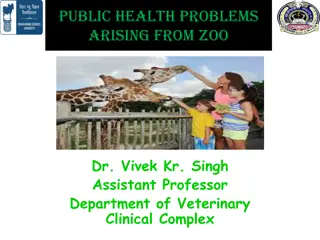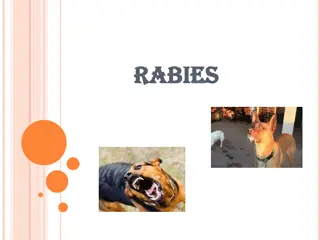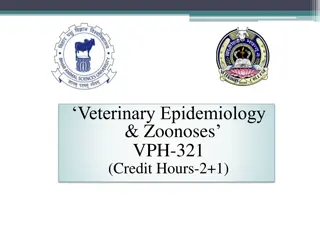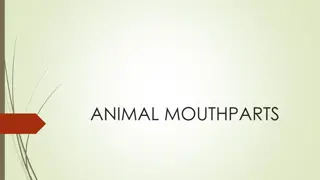The Prevention of Cruelty to Animals Act, 1960 Overview
The Prevention of Cruelty to Animals Act, 1960, is a legislation in India aimed at safeguarding the well-being of animals and preventing unnecessary pain or suffering. It defines important terms like animals, domestic animals, local authority, owner, and outlines the responsibilities of individuals
0 views • 16 slides
Understanding Laboratory Animals and Their Classification
Laboratory animals play a crucial role in scientific research due to their physiological similarity to humans. Common types include mice, rats, hamsters, guinea pigs, rabbits, and monkeys. They are classified into conventional and gnotobiotic animals based on their microbial status. Specific pathoge
1 views • 67 slides
Understanding the Importance of Skin and Hides in Livestock Industry
Skin and hides are crucial by-products of large and small animals, with differences in thickness and weight. They are sourced from slaughtered and fallen animals, processed through drying, tanning, and conditioning to produce leather. Leather has outstanding strength, flexibility, and weather insula
0 views • 16 slides
Common Offences Against Animals in India: Overview and Consequences
There are three common offences against animals in India: mischief, cruelty, and bestiality. Mischief involves killing, poisoning, or harming animals, punishable under IPC Sections 428 and 429. Cruelty includes acts like beating, overloading, and starvation, regulated by the Prevention of Cruelty to
0 views • 21 slides
Understanding Endangered Animals and Extinction
Explore the concept of endangered animals and extinction through tasks that involve listing endangered animals, understanding reasons for extinction, researching specific endangered species, and contemplating the ethical dilemma of keeping animals in zoos. Engage in critical thinking and research to
0 views • 8 slides
Importance of Transport System in Animals for Oxygen Supply
Animals require a transport system to meet tissue oxygen demands efficiently. The size limit for oxygen diffusion alone is around 1 mm due to the proportional increase in radius and diffusion properties. Blood is crucial for transporting oxygen, nutrients, waste products, cells, and heat, as well as
0 views • 17 slides
Understanding Public Health Risks Associated with Zoos and Wild Animals
Zoos and wildlife parks serve as hubs for public recreation and education but can also pose public health risks due to potential transmission of zoonotic diseases by veterinarians who work closely with wild animals. Approximately 61% of infectious agents affecting humans are zoonotic in nature, with
0 views • 15 slides
Understanding Fossorial Adaptation in Animals
Animals adapt to subterranean environments through anatomical and physiological modifications in a process known as fossorial adaptation. This adaptation involves creating subterranean zones through digging, leading to changes influenced by both the environment and the animals themselves. Fossorial
0 views • 17 slides
Animals by Walt Whitman: Embracing the Virtues of Animals Over Humans
Walt Whitman's poem "Animals" expresses a longing to live among animals due to their peaceful and self-controlled nature, contrasting them with the perceived greed and jealousy of humans. The poet finds solace in the virtues displayed by animals and reflects on their simplicity and contentment, high
0 views • 16 slides
Understanding Rabies: Epidemiology, Etiology, and Control Measures
Rabies is an acute fatal disease affecting humans and warm-blooded animals worldwide. It is characterized by abnormal behavior, nervous disturbances, and ultimately death due to respiratory paralysis. Rabies claims approximately 55,000 human lives annually, with efforts at control showing marginal s
1 views • 22 slides
Salmonellosis: Causes, Clinical Presentations, and Transmission
Salmonellosis is caused by the gram-negative bacterium Salmonella enterica. It predominantly affects warm-blooded vertebrates, leading to carrier states, septicemia, enteritis, and other clinical presentations like abortion and arthritis. The disease is transmitted through contaminated foods of anim
0 views • 15 slides
Learn Plural and Singular Forms with Animals in English
This lesson focuses on differentiating between plural and singular forms using animals as examples. Students will learn to write sentences using "They're" for plural and "It's a" for singular, while looking at pictures of various animals. By the end of the lesson, students will be confident in using
1 views • 6 slides
Overview of Laboratory Animals and Their Uses in Biomedical Research
Laboratory animals play a crucial role in biomedical research, serving as models for studying various conditions affecting humans and animals. They must thrive in controlled conditions and are used to test hypotheses and drugs. Commonly used lab animals include rodents, lagomorphs, canines, felines,
0 views • 9 slides
Understanding Arboreal Adaptation in Animals
Arboreal locomotion refers to the movement through trees exhibited by animals like squirrels, sloths, and monkeys. These animals possess physical adaptations such as long limbs, prehensile tails, and claws to aid in tree climbing. Arboreal life offers safety, retreat, and easy access to food, shapin
0 views • 14 slides
Understanding Aquatic Adaptation in Animals
Aquatic adaptation refers to the changes in an animal's body organization to thrive in a water habitat. Vertebrates have evolved to lead partial or total aquatic lives, showcasing various adaptations. Water as a habitat offers a homogenous medium, stable conditions, and rich food resources. Aquatic
0 views • 9 slides
Understanding Rabies: Causes, Symptoms, and Prevention
Rabies is an acute and highly fatal viral disease of the central nervous system, caused by Lyssavirus type 1. It is a zoonotic disease that affects warm-blooded animals such as dogs, cats, bats, racoons, skunks, and foxes. The disease is primarily transmitted to humans through the bite of a rabid an
2 views • 6 slides
Common Offences Against Animals in India: Understanding Mischief, Cruelty, and Bestiality
Offences against animals in India encompass mischief, cruelty, and bestiality. Mischief involves killing, poisoning, and maiming animals, punishable under the IPC. Maiming makes animals permanently useless, often to harm owners. Cruelty includes beating, overloading, starvation, and other forms of a
0 views • 17 slides
Understanding Rabies: A Comprehensive Overview
Rabies is an acute fatal disease affecting humans and warm-blooded animals, characterized by abnormal behavior, nervous disturbances, excessive salivation, and respiratory paralysis. It claims around 55,000 human lives globally, with efforts in rabies control showing marginal success. The etiology o
0 views • 22 slides
Walt Whitman's Poem: Animals and Their Serenity
Walt Whitman's poem explores the tranquility and simplicity of animals compared to the complexities of human existence. He marvels at how animals do not dwell on dissatisfaction or material possession, finding solace in their self-sufficiency. Through vivid imagery and free verse, the poet reflects
0 views • 7 slides
Understanding Insulation and Energy Efficiency in Grade 7 Natural Sciences
Exploring the importance of insulation in managing heat transfer, this Grade 7 Natural Sciences topic covers heat transfer mechanisms, energy savings, and solar water heating systems. Learn about warm-blooded organisms' ability to regulate body temperature and how energy efficiency plays a crucial r
7 views • 9 slides
Insights into Hibernation in Animals: Functions and Varieties
Hibernation is a fascinating biological phenomenon observed in various animals, enabling them to survive harsh conditions by conserving energy. This state of inactivity and metabolic depression is crucial for species like bears, pygmy possums, and bats during winter months. Animals hibernate to cope
0 views • 15 slides
Service and Assistance Animals Guidelines at RIT
Service and Assistance Animals Guidelines at RIT provide information on the definition of service and assistance animals, request procedures, expectations of animal and owner, and how to address concerns. The policy distinguishes between service animals trained to perform tasks for individuals with
0 views • 15 slides
Insights into Walt Whitman's Poem "Animals": A Journey of Self-Discovery
Walt Whitman's poem "Animals" delves into the poet's contemplation of living with animals for their peaceful and self-contained nature compared to complex human interactions. Through vivid imagery and free verse, Whitman expresses admiration for animals' contentment, lack of materialistic desires, a
4 views • 7 slides
Distribution and Adaptation of Warm-Blooded Animals on Earth
The distribution of warm-blooded animals shows regularities based on their size and environmental adaptations. From the Fennec Fox in North Africa to the Emperor Penguin in Antarctica, different species have evolved to thrive in diverse habitats based on their morphological features. Bergmann's rule
1 views • 16 slides
Learn About Animals Through This Interactive PowerPoint Presentation
Explore the fascinating world of animals in this interactive PowerPoint presentation. Discover the six groups of animals categorized in unique classes with fun facts and engaging visuals. You'll get to learn about mammals, birds, and more while filling in blanks and pasting pictures of different ani
0 views • 29 slides
Understanding Rabies: A Comprehensive Overview of the Disease
Rabies, also known as hydrophobia or mad dog disease, is a deadly viral infection that affects warm-blooded animals, including humans. This article delves into the etiology, features of the virus, and epidemiology of rabies, emphasizing its prevention and control measures to combat this fatal zoonot
0 views • 24 slides
Service Animals for Veterans in Georgia: A Guide to VA Guidance
Veterans in Georgia can benefit from service animals, including guide dogs and trained service animals, to assist with physical or mental impairments. The VA provides guidelines for evaluating, approving, and supporting veterans in receiving and caring for service animals. This includes information
0 views • 8 slides
Become a Foster Parent for AAWL: Steps and Requirements
Join the Arizona Animal Welfare League's Foster Care Program by following the steps outlined: complete the application, attend orientation, and provide a separate living space and transportation for foster animals. Learn why fostering young animals is crucial and the guidelines for integrating them
0 views • 14 slides
Understanding Food Sources: Plants and Animals Explained
Food is essential for nourishing our bodies, and it comes from either plants or animals. Plants provide fruits, vegetables, grains, and more, while animals offer products like meat, milk, and eggs. Different parts of plants, such as roots, stems, and leaves, are consumed as food. Animals have varied
0 views • 11 slides
Exploring Humorous Techniques in Carolyn Wells' Poem on Wild Animals
The poem by Carolyn Wells humorously depicts the characteristics of wild animals, treating even ferocious beasts with a coat of gentle but weird humor. Through witty language and ironic twists, the poetess describes the different wild animals and their dangerous behaviors, highlighting the risks of
0 views • 12 slides
Exploring What Makes Whales Unique in the Marine Mammal World
Delve into the fascinating world of whales, understanding the key characteristics that distinguish them as mammals of the sea. From warm-blooded creatures with backbones to air-breathing giants, witness how whales give birth to live young, nurse their offspring, and truly embody the essence of marin
0 views • 25 slides
Understanding Warm Lines: A Vital Support System Beyond Crisis Intervention
In the realm of mental health support, warm lines serve as invaluable resources beyond crisis intervention hotlines. Originating in the late 1950s, these lines cater to individuals facing non-crisis challenges such as depression, loneliness, and relationship issues. Project Return Peer Support Netwo
0 views • 27 slides
Understanding Animal Welfare and Five Freedoms in Farming
Animal welfare encompasses physical and mental wellbeing, allowing animals to express natural behaviors. The Five Freedoms outline essential welfare needs, making sure animals are free from hunger, discomfort, pain, fear, and distress. The Farm Animal Welfare Council ensures these needs are met for
0 views • 16 slides
Evolutionary Adaptations in Animals and Their Mouthparts
Environmental conditions have influenced the evolution of animals, leading to adaptations that allow them to survive and thrive. One crucial aspect is the relationship between animals, their environment, and food sources, shaping physical traits like mouthparts for efficient feeding. Explore how dif
0 views • 9 slides
Fascinating Facts About Birds: From Egg-laying to Hunting Techniques
Birds are warm-blooded creatures with feathers and wings, ranging from tiny hummingbirds to large albatrosses. They lay eggs and build nests in various ways. Some birds, like falcons, are skilled hunters, using their speed and agility to catch prey. Explore the intriguing world of birds and their be
0 views • 5 slides
Understanding Dangers to Animals: Predators and Habitat Loss
Animals face various dangers in their natural habitats, including predators and habitat loss. Predators like owls, bobcats, and racoons hunt other animals, while habitat loss, such as the melting Arctic ice cap, threatens species like polar bears. Human activities, like beach development, also impac
0 views • 19 slides
Learn Where Different Animals Live - Educational English Lesson for Class Two Students
In this engaging English lesson designed for Class Two students, they will explore where animals live through visual aids and interactive learning activities. The lesson covers various animals like birds, snakes, cows, tigers, and more, teaching students about their habitats in a fun and educational
0 views • 22 slides
Managing Service Animals and Emotional Support Animals in Compliance with ADA and HUD Guidelines
This presentation by James Whitfield explores the management of service animals and emotional support animals on campus under OCR and HUD guidelines. The session covers defining service animals, identifying them in training, recognizing emotional support animals, and understanding the distinctions b
1 views • 52 slides
Wildlife Warden Duties and Performing Animals Welfare Guidelines
Every state and union territory in India has a Wildlife Advisory Board to aid in wildlife protection, with Wildlife Wardens playing a key role in conservation efforts. They focus on preventing poaching, protecting wildlife habitats, and engaging with local communities. Additionally, guidelines are s
0 views • 8 slides
Understanding Migration and Hibernation in Animals
Explore the fascinating behaviors of birds during migration and animals during hibernation. Discover how animals adapt to survive in changing environments, the reasons behind hibernation, dangers involved, and how different animals prepare for winter. Learn about light sleepers that are not true hib
0 views • 17 slides







































